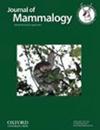Genetic diversity and complex structure of the European Roe Deer population at a continental scale
IF 1.5
3区 生物学
Q2 ZOOLOGY
引用次数: 0
Abstract
Abstract Although the European Roe Deer (Capreolus capreolus) is one of the most common and widespread ungulate species in Europe and inhabiting a variety of habitats, few studies have addressed its population structure at a large spatial scale using nuclear genetic data. The aims of our study were to: (i) investigate genetic diversity, level of admixture, and genetic structure across European Roe Deer populations; (ii) identify barriers to gene flow; and (iii) reveal factors that have impacted the observed pattern of population genetic structure. Using 12 microsatellite loci, we analyzed 920 European Roe Deer samples from 16 study sites from northern, southern, central, and eastern Europe. The highest genetic diversity was found in central and eastern sites, and lowest in the northern and southern sites. There were 2 main groups of genetically related populations in the study area—one inhabiting mainly Fennoscandia, and the second in the continental part of Europe. This second population was further divided into 3 to 5 spatially distributed genetic clusters. European Roe Deer belonging to the Siberian mitochondrial DNA clade, inhabiting large parts of eastern Europe, were not identified as a separate population in the analysis of microsatellite loci. No isolation by distance (IBD) was detected between roe deer from the fennoscandian and the continental study sites, but the Baltic Sea was inferred to be the main barrier to gene flow. Only weak IBD was revealed within the continental population. Three lower-level genetic barriers were detected in the western, southern, and eastern parts of the study area. The main factors inferred as shaping the observed genetic diversity and population structure of European Roe Deer were postglacial recolonization, admixture of different populations of the species originating from several Last Glacial Maximum refugial areas, and isolation of several study sites.大陆范围内欧洲狍种群的遗传多样性和复杂结构
摘要欧洲狍子(Capreolus Capreolus)是欧洲最常见、分布最广的有蹄类物种之一,栖息于多种生境,但利用核遗传数据在大空间尺度上研究其种群结构的研究很少。本研究的目的是:(i)调查欧洲狍种群的遗传多样性、混合水平和遗传结构;确定基因流动的障碍;(3)揭示影响观察到的种群遗传结构格局的因素。利用12个微卫星位点,我们分析了来自北欧、南欧、中欧和东欧16个研究地点的920份欧洲狍样本。遗传多样性最高的是中部和东部,最低的是北部和南部。研究区主要有2个遗传相关群体,一个主要居住在芬诺斯坎迪亚,另一个主要居住在欧洲大陆。第二居群进一步划分为3 ~ 5个空间分布的遗传群。欧洲狍属于西伯利亚线粒体DNA分支,居住在东欧的大部分地区,在微卫星位点分析中没有被确定为一个单独的种群。fennoscandian和大陆研究地点的狍之间没有发现距离隔离(IBD),但推断波罗的海是基因流动的主要屏障。仅在大陆人群中发现弱IBD。在研究区西部、南部和东部分别检测到3个较低水平的遗传屏障。形成欧洲狍遗传多样性和种群结构的主要因素是冰川后的再定居、来自末次冰期极大期多个保护区的不同种群的混合以及多个研究地点的隔离。
本文章由计算机程序翻译,如有差异,请以英文原文为准。
求助全文
约1分钟内获得全文
求助全文
来源期刊

Journal of Mammalogy
生物-动物学
CiteScore
3.30
自引率
5.90%
发文量
106
审稿时长
4-8 weeks
期刊介绍:
Papers are published on mammalian behavior, conservation, ecology, genetics, morphology, physiology, and taxonomy.
 求助内容:
求助内容: 应助结果提醒方式:
应助结果提醒方式:


